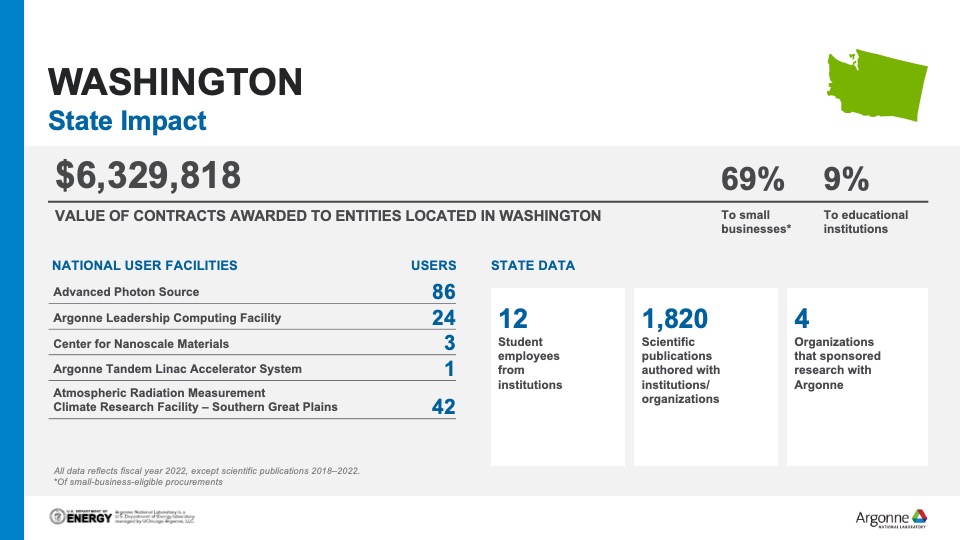Looking forward to nuclear power in a changing climate
The current nuclear reactor design employed at Washington’s one and only nuclear power plant relies on a steady, cool flow of water from the Columbia River to keep its temperature down. It produces nearly zero greenhouse gas emissions and roughly 8% of the state’s electricity. A changing climate and the expected rising demand for more clean energy has inspired Energy Northwest to work with nuclear and climate scientists at the U.S. Department of Energy’s (DOE) Argonne National Laboratory. These experts will use DOE Gateway for Accelerated Innovation in Nuclear (GAIN) funding to inform the design and selection of future nuclear reactor cooling systems and their impacts on electricity cost under different climate scenarios.
University of Washington and Argonne researchers discover new tunable superconducting material
As industrial computing needs grow, the size and energy consumption of the hardware needed to keep up with those needs grows as well. A possible solution to this dilemma could be found in superconducting materials, which can reduce that energy consumption exponentially. Imagine cooling a giant data center full of constantly running servers down to nearly absolute zero, enabling large-scale computation with incredible energy efficiency.
Physicists at the University of Washington and DOE’s Argonne have made a discovery that could help enable this more efficient future. Researchers have found a superconducting material that is uniquely sensitive to outside stimuli, enabling the superconducting properties to be enhanced or suppressed at will. This enables new opportunities for energy-efficient switchable superconducting circuits. The paper was published in Science Advances
The team used a number of X-ray science techniques at the Advanced Photon Source (APS), a DOE Office of Science user facility at Argonne, to confirm the properties of the material.
“This material is exciting because you have a close competition between multiple phases, and by applying a small strain or magnetic field, you can boost one phase over the other to turn the superconductivity on and off,” said lead author Shua Sanchez of the University of Washington. “The vast majority of superconductors aren’t nearly as easily switchable.”
Partnership between UW and Argonne on peptide research could lead to new drugs
University of Washington researchers, led by David Baker, head of the Institute for Protein Design, are working with the Argonne to advance protein structure modeling capabilities. These same tools also are enabling the design of synthetic mini-proteins, known as peptides, for the treatment of an array of diseases, such as influenza and coronavirus. Proteins are complex molecules that drive virtually all cellular functions, and the design of new ones could significantly reduce the costs associated with drug design and discovery research.
The Argonne Leadership Computing Facility staff helped implement a molecular design algorithm in the General Atomic and Molecular Electronic Structure System (GAMESS), developed scripts to generate inputs and run large numbers of calculations, and assisted with analysis and interpretation of the results. The study was published in the Journal of Computational Chemistry. The team’s discovery by computation of new stable peptides provides valuable data for improving molecular force fields. More broadly, the design of synthetic peptides could unlock new medicines, manufacturing, and materials science, including the design of new therapeutics to combat infectious disease.
UW and Argonne seek pivotal discoveries to rescue failing hearts
The University of Washington’s Center for Translational Muscle Research has been studying muscle structure and function at nanometer and millisecond scales with experimental data collected at Argonne’s APS by Illinois Institute of Technology’s Biophysics Collaborative Access Team (BioCAT). These studies could help improve therapies to rescue failing hearts.
The heart muscle contractions that pump blood are generated by interactions between actin and myosin. Myosin is a motor protein that powers movement at the molecular level by converting the molecule ATP into energy. Earlier research in the lab of Michael Regnier, University of Washington (UW) professor of bioengineering, had shown that dATP, a natural variant of ATP, can be used to promote stronger heart function. But there remains a pressing need for data to explain why dATP helps to increase contractile force in heart disease. A new study headed by Dr. Regnier, who is also a researcher at the UW Medicine Institute for Stem Cell and Regenerative Medicine and Director of the Center for Translational Muscle Research, offers new insights, with unprecedented precision, about the nature of dATP. The results were detailed in the journal Proceeding of the National Academy of Sciences of the United States of America. The research team includes scientists from the University of Washington, the University of California, San Diego and the Illinois Institute of Technology.
TerraPower and ARC partner with Argonne for safer nuclear reactors
TerraPower, LLC (Bellevue, Washington) and Advanced Reactor Concepts, LLC (Chevy Chase, Maryland) partnered with Argonne on SAS4A/SASSYS-1 software for the authorization and licensing process of sodium-cooled fast nuclear reactors. SAS4A/SASSYS-1 is a simulation tool for analysts determining the safety of a reactor design that may be subjected to range of high temperatures, high power and other off-normal conditions, according to Acacia J. Brunett, principal nuclear engineer in Argonne’s Nuclear Science and Engineering division.
A utility, vendor or other industry member must obtain authorization from DOE, or a license from the U.S. Nuclear Regulatory Commission (NRC), to build the reactor. The applicant first must demonstrate the safety of their proposed design to DOE or NRC, where the pedigree and suitability of the simulation software used to show design acceptance is also confirmed. In July 2019, DOE provided funding for the project, supported by the Technology Commercialization Fund, managed by DOE’s Office of Technology Transitions.





